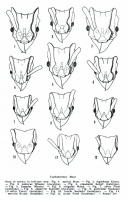Mycetophylax plaumanni
| Mycetophylax plaumanni | |
|---|---|
| Scientific classification | |
| Kingdom: | Animalia |
| Phylum: | Arthropoda |
| Class: | Insecta |
| Order: | Hymenoptera |
| Family: | Formicidae |
| Subfamily: | Myrmicinae |
| Tribe: | Attini |
| Genus: | Mycetophylax |
| Species: | M. plaumanni |
| Binomial name | |
| Mycetophylax plaumanni (Kempf, 1962) | |
Only known from the type specimens.
Identification
Distribution
Latitudinal Distribution Pattern
Latitudinal Range: -21.16666667° to -27.644°.
| North Temperate |
North Subtropical |
Tropical | South Subtropical |
South Temperate |
- Source: AntMaps
Distribution based on Regional Taxon Lists
Neotropical Region: Brazil (type locality).
Distribution based on AntMaps
Distribution based on AntWeb specimens
Check data from AntWeb
Countries Occupied
| Number of countries occupied by this species based on AntWiki Regional Taxon Lists. In general, fewer countries occupied indicates a narrower range, while more countries indicates a more widespread species. |

|
Estimated Abundance
| Relative abundance based on number of AntMaps records per species (this species within the purple bar). Fewer records (to the left) indicates a less abundant/encountered species while more records (to the right) indicates more abundant/encountered species. |

|
Biology
|
Castes
Nomenclature
The following information is derived from Barry Bolton's Online Catalogue of the Ants of the World.
- plaumanni. Cyphomyrmex plaumanni Kempf, 1962b: 31, figs. 29-31 (w.) BRAZIL.
- Combination in Mycetophylax: Sosa-Calvo et al., 2017: 9.
- See also: Kempf, 1964d: 16.
Description
Worker
Kempf (1964) - Total length 3.2-3.4 mm; head length 0.82-0.91 mm; head width 0.69-0.79 mm; thorax length 0.98-1.07 mm; hind femur length 0.72-0.83 mm. Fuscous brown; opaque. Rather close to strigatus, with the following diagnostic characters: 1) Postero-median portion of clypeus of peculiar shape, with the teeth close together, and prominently overhanging the vertical and slightly excavate anterior portion of clypeus (fig 4). 2) Frontal carinae scarcely expanded in front, scarcely rounded, little constricted behind. 3) Preocular carina reaching back to occipital corner as a well-developed, slightly raised carinule, never just vestigial behind eyes. 4) Femora and tibiae prismatic, hind femora broadened beneath ab basal third, with a prominent foliaceous laminule projecting from the posterior border which, in side view, forms a distinct angle. Apical half of tibial borders distinctly marginate. 5) Postpetiole scarcely elevated in front, without an anterior vertical face; conspicuously transverse and never longer than petiolar node (fig 17). 6) Appressed pilosity fine, minute and inconspicuous, never scale-like.
Type Material
Kempf (1964) - Holotype worker from Nova Teutônia, Santa Catarina State, Brazil (Plaumann) Oct. 1955; 3 paratypes workers likewise from southeastern Brazil: Rio Grande do Sul State, Barros Cassal, Sept. 1960 (F. Plaumann) 1 worker; Erechim, July 1960 (F. Plaumann) 1 worker; Paraná State: Rio Azul, 1000 m, October 1959 (F. Plaumann) 1 worker. All in this author's collection (WWK).
References
- Kempf, W. W. 1962b. Miscellaneous studies on neotropical ants. II. (Hymenoptera, Formicidae). Stud. Entomol. 5: 1-38 (page 31, figs. 29-31 worker described)
- Kempf, W. W. 1964d. A revision of the Neotropical fungus-growing ants of the genus Cyphomyrmex Mayr. Part I: Group of strigatus Mayr (Hym., Formicidae). Stud. Entomol. 7: 1-44 (page 16, see also)
- Sosa-Calvo, J., JesÏovnik, A., Vasconcelos, H.L., Bacci, M. Jr., Schultz, T.R. 2017. Rediscovery of the enigmatic fungus-farming ant "Mycetosoritis" asper Mayr (Hymenoptera: Formicidae): Implications for taxonomy, phylogeny, and the evolution of agriculture in ants. PLoS ONE 12: e0176498 (DOI 10.1371/journal.pone.0176498).
References based on Global Ant Biodiversity Informatics
- Klingenberg, C. and C.R.F. Brandao. 2005. The type specimens of fungus growing ants, Attini (Hymenoptera, Formicidae, Myrmicinae) deposited in the Museu de Zoologia da Universidade de Sao Paulo, Brazil. Papeis Avulsos de Zoologia 45(4):41-50

